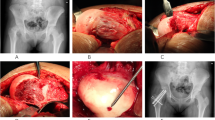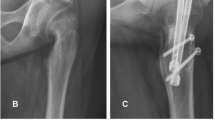Abstract
Background
The most important objective of clinical classifications of slipped capital femoral epiphysis (SCFE) is to identify hips associated with a high risk of avascular necrosis (AVN) — so-called unstable or acute slips; however, closed surgery makes confirmation of physeal stability difficult. Performing the capital realignment procedure in SCFE treatment we observed that clinical estimation of physeal stability did not always correlate with intraoperative findings at open surgery. This motivated us to perform a systematic comparison of the clinical classification systems with the intraoperative observations.
Questions/purposes
We asked: (1) Is the classification of an acute versus chronic slip based on the duration of symptoms sensitive and specific in detecting intraoperative disrupted physes in patients with SCFE? (2) Is the stable/unstable classification system based on clinical symptoms sensitive and specific in detecting intraoperative disrupted physes in patients with SCFE?
Methods
We retrospectively reviewed 82 patients with SCFE treated by open surgery between 1996 and 2009. We classified the clinical stability of all hips using the classifications based on onset of symptoms and on function. We classified intraoperative stability as intact or disrupted. We determined the sensitivity and specificity of two classification systems to determine intraoperative stability.
Results
Complete physeal disruption at open surgery was seen in 28 of the 82 hips (34%). With classification as acute, acute-on-chronic, and chronic, the sensitivity for disrupted physes was 82% and the specificity was 44%. With the classification of Loder et al., the values were 39% and 76%, respectively.
Conclusion
Current clinical classification systems are limited in accurately diagnosing the physeal stability in SCFE.
Level of Evidence
Level III, retrospective diagnostic study. See Guidelines for Authors for a complete description of levels of evidence.


Similar content being viewed by others
References
Aadalen RJ, Weiner DS, Hoyt W, Herndon CH. Acute slipped capital femoral epiphysis. J Bone Joint Surg Am. 1974;56:1473–1487.
Aronsson DD, Karol LA. Stable slipped capital femoral epiphysis: evaluation and management. J Am Acad Orthop Surg. 1996;4:173–181.
Aronsson DD, Loder RT. Treatment of the unstable (acute) slipped capital femoral epiphysis. Clin Orthop Relat Res. 1996;322:99–110.
Aronsson DD, Loder RT, Breur GJ, Weinstein SL. Slipped capital femoral epiphysis: current concepts. J Am Acad Orthop Surg. 2006;14:666–679.
Ballard J, Cosgrove AP. Anterior physeal separation: a sign indicating a high risk for avascular necrosis after slipped capital femoral epiphysis. J Bone Joint Surg Br. 2002;84:1176–1179.
Billing L, Eklof O. Slip of the capital femoral epiphysis: revival of a method of assessment. Pediatr Radiol. 1984;14:413–418.
Boyer DW, Mickelson MR, Ponseti IV. Slipped capital femoral epiphysis: long-term follow-up study of one hundred and twenty-one patients. J Bone Joint Surg Am. 1981;63:85–95.
Burrows HJ. Slipped upper femoral epiphysis: characteristic of a hundred cases. J Bone Joint Surg Br. 1957;39:641–658.
Carney BT, Weinstein SL. Natural history of untreated chronic slipped capital femoral epiphysis. Clin Orthop Relat Res. 1996;322:43–47.
Carney BT, Weinstein SL, Noble J. Long-term follow-up of slipped capital femoral epiphysis. J Bone Joint Surg Am. 1991;73:667–674.
Casey BH, Hamilton HW, Bobechko WP. Reduction of acutely slipped upper femoral epiphysis. J Bone Joint Surg Br. 1972;54:607–614.
Castaneda P, Macias C, Rocha A, Harfush A, Cassis N. Functional outcome of stable grade III slipped capital femoral epiphysis treated with in situ pinning. J Pediatr Orthop. 2009;29:454–458.
Dendane MA, Amrani A, El Alami Z, El Medhi T, Gourinda H. [Risk factors of osteonecrosis of the femoral head following slipped capital femoral epiphysis] [in French]. Rev Med Brux. 2010;31:88–92.
Dunn DM. The treatment of adolescent slipping of the upper femoral epiphysis. J Bone Joint Surg Br. 1964;46:621–629.
Engelhardt P. [Natural course of epiphysiolysis of the femur head] [in German]. Orthopade. 1994;23:195–199.
Exner GU, Schai PA, Notzli HP. [Treatment of acute slips and clinical results in slipped capital femoral epiphysis] [in German]. Orthopade. 2002;31:857–865.
Fahey JJ, O’Brien ET. Acute slipped capital femoral epiphysis: review of the literature and report of ten cases. J Bone Joint Surg Am. 1965;47:1105–1127.
Fallath S, Letts M. Slipped capital femoral epiphysis: an analysis of treatment outcome according to physeal stability. Can J Surg. 2004;47:284–289.
Fidler MW, Brook CG. Slipped capital femoral epiphysis following treatment with human growth hormone. J Bone Joint Surg Am. 1974;56:1719–1722.
Ganz R, Gill TJ, Gautier E, Ganz K, Krugel N, Berlemann U. Surgical dislocation of the adult hip a technique with full access to the femoral head and acetabulum without the risk of avascular necrosis. J Bone Joint Surg Br. 2001;83:1119–1124.
Ganz R, Huff TW, Leunig M. Extended retinacular soft-tissue flap for intra-articular hip surgery: surgical technique, indications, and results of application. Instr Course Lect. 2009;58:241–255.
Gholve PA, Cameron DB, Millis MB. Slipped capital femoral epiphysis update. Curr Opin Pediatr. 2009;21:39–45.
Harland U, Krappel FA. [Value of ultrasound, CT, and MRI in the diagnosis of slipped capital femoral epiphysis (SCFE)] [in German]. Orthopade. 2002;31:851–856.
Herman MJ, Dormans JP, Davidson RS, Drummond DS, Gregg JR. Screw fixation of Grade III slipped capital femoral epiphysis. Clin Orthop Relat Res. 1996;322:77–85.
Kallio PE, Mah ET, Foster BK, Paterson DC, LeQuesne GW. Slipped capital femoral epiphysis: incidence and clinical assessment of physeal instability. J Bone Joint Surg Br. 1995;77:752–755.
Kallio PE, Paterson DC, Foster BK, Lequesne GW. Classification in slipped capital femoral epiphysis: sonographic assessment of stability and remodeling. Clin Orthop Relat Res. 1993;294:196–203.
Kalogrianitis S, Tan CK, Kemp GJ, Bass A, Bruce C. Does unstable slipped capital femoral epiphysis require urgent stabilization? J Pediatr Orthop B. 2007;16:6–9.
Kennedy JG, Hresko MT, Kasser JR, Shrock KB, Zurakowski D, Waters PM, Millis MB. Osteonecrosis of the femoral head associated with slipped capital femoral epiphysis. J Pediatr Orthop. 2001;21:189–193.
Lehmann CL, Arons RR, Loder RT, Vitale MG. The epidemiology of slipped capital femoral epiphysis: an update. J Pediatr Orthop. 2006;26:286–290.
Leunig M, Casillas MM, Hamlet M, Hersche O, Notzli H, Slongo T, Ganz R. Slipped capital femoral epiphysis: early mechanical damage to the acetabular cartilage by a prominent femoral metaphysis. Acta Orthop Scand. 2000;71:370–375.
Leunig M, Slongo T, Kleinschmidt M, Ganz R. Subcapital correction osteotomy in slipped capital femoral epiphysis by means of surgical hip dislocation. Oper Orthop Traumatol. 2007;19:389–410.
Loder RT. The demographics of slipped capital femoral epiphysis: an international multicenter study. Clin Orthop Relat Res. 1996;322:8–27.
Loder RT. Unstable slipped capital femoral epiphysis. J Pediatr Orthop. 2001;21:694–699.
Loder RT, Aronsson DD, Weinstein SL, Breur GJ, Ganz R, Leunig M. Slipped capital femoral epiphysis. Instr Course Lect. 2008;57:473–498.
Loder RT, Richards BS, Shapiro PS, Reznick LR, Aronson DD. Acute slipped capital femoral epiphysis: the importance of physeal stability. J Bone Joint Surg Am. 1993;75:1134–1140.
Loyd RD, Evans JP. Acute slipped capital femoral epiphysis. South Med J. 1975;68:857–862.
Lubicky JP. Chondrolysis and avascular necrosis: complications of slipped capital femoral epiphysis. J Pediatr Orthop B. 1996;5:162–167.
Mooney JF 3rd, Sanders JO, Browne RH, Anderson DJ, Jofe M, Feldman D, Raney EM. Management of unstable/acute slipped capital femoral epiphysis: results of a survey of the POSNA membership. J Pediatr Orthop. 2005;25:162–166.
Parsch K, Weller S, Parsch D. Open reduction and smooth Kirschner wire fixation for unstable slipped capital femoral epiphysis. J Pediatr Orthop. 2009;29:1–8.
Phillips SA, Griffiths WE, Clarke NM. The timing of reduction and stabilisation of the acute, unstable, slipped upper femoral epiphysis. J Bone Joint Surg Br. 2001;83:1046–1049.
Rattey T, Piehl F, Wright JG. Acute slipped capital femoral epiphysis: review of outcomes and rates of avascular necrosis. J Bone Joint Surg Am. 1996;78:398–402.
Schein AJ. Acute severe slipped capital femoral epiphysis. Clin Orthop Relat Res. 1967;51:151–166.
Sevitt S, Thompson RG. The distribution and anastomoses of arteries supplying the head and neck of the femur. J Bone Joint Surg Br. 1965;47:560–573.
Slavkovic N, Vukasinovic Z, Slavkovic S. [Factors influencing the development of avascular necrosis in non-operative treatment of the acute slipped capital femoral epiphysis] [in Serbian]. Srp Arh Celok Lek. 2007;135:54–60.
Southwick WO. Osteotomy through the lesser trochanter for slipped capital femoral epiphysis. J Bone Joint Surg Am. 1967;49:807–835.
Tins B, Cassar-Pullicino V, McCall I. The role of pre-treatment MRI in established cases of slipped capital femoral epiphysis. Eur J Radiol. 2009;70:570–578.
Tokmakova KP, Stanton RP, Mason DE. Factors influencing the development of osteonecrosis in patients treated for slipped capital femoral epiphysis. J Bone Joint Surg Am. 2003;85:798–801.
Weiner D. Pathogenesis of slipped capital femoral epiphysis: current concepts. J Pediatr Orthop B. 1996;5:67–73.
Weiner DS. Management of unstable/acute slipped capital femoral epiphysis. J Pediatr Orthop. 2007;27:363; author reply 363.
Weinstein SL. Natural history and treatment outcomes of childhood hip disorders. Clin Orthop Relat Res. 1997;344:227–242.
Witbreuk M, Besselaar P, Eastwood D. Current practice in the management of acute/unstable slipped capital femoral epiphyses in the United Kingdom and the Netherlands: results of a survey of the membership of the British Society of Children’s Orthopaedic Surgery and the Werkgroep Kinder Orthopaedie. J Pediatr Orthop B. 2007;16:79–83.
Ziebarth K, Zilkens C, Spencer S, Leunig M, Ganz R, Kim YJ. Capital realignment for moderate and severe SCFE using a modified Dunn procedure. Clin Orthop Relat Res. 2009;467:704–716.
Acknowledgments
We thank Joseph M. Schwab MD for assistance in the preparation of this manuscript.
Author information
Authors and Affiliations
Corresponding author
Additional information
Each author certifies that he or she, or a member of their immediate family, has no commercial associations (eg, consultancies, stock ownership, equity interest, patent/licensing arrangements, etc) that might pose a conflict of interest in connection with the submitted article.
All ICMJE Conflict of Interest Forms for authors and Clinical Orthopaedics and Related Research editors and board members are on file with the publication and can be viewed on request.
Each author certifies that his or her institution approved the human protocol for this investigation, that all investigations were conducted in conformity with ethical principles of research, and that informed consent for participation in the study was obtained.
About this article
Cite this article
Ziebarth, K., Domayer, S., Slongo, T. et al. Clinical Stability of Slipped Capital Femoral Epiphysis does not Correlate with Intraoperative Stability. Clin Orthop Relat Res 470, 2274–2279 (2012). https://doi.org/10.1007/s11999-012-2339-y
Received:
Accepted:
Published:
Issue Date:
DOI: https://doi.org/10.1007/s11999-012-2339-y




